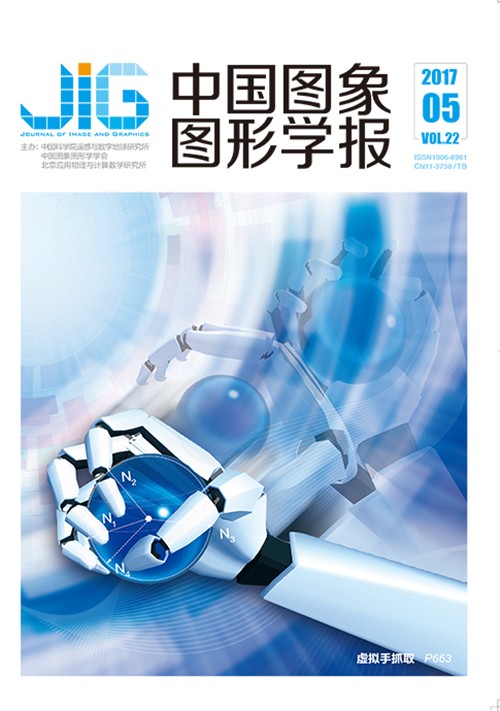
遥感图像飞机目标分类的卷积神经网络方法
摘 要
目的 遥感图像飞机目标分类,利用可见光遥感图像对飞机类型进行有效区分,对提供军事作战信息有重要意义。针对该问题,目前存在一些传统机器学习方法,但这些方法需人工提取特征,且难以适应真实遥感图像的复杂背景。近年来,深度卷积神经网络方法兴起,网络能自动学习图像特征且泛化能力强,在计算机视觉各领域应用广泛。但深度卷积神经网络在遥感图像飞机分类问题上应用少见。本文旨在将深度卷积神经网络应用于遥感图像飞机目标分类问题。方法 在缺乏公开数据集的情况下,收集了真实可见光遥感图像中的8种飞机数据,按大致4∶1的比例分为训练集和测试集,并对训练集进行合理扩充。然后针对遥感图像与飞机分类的特殊性,结合深度学习卷积神经网络相关理论,有的放矢地设计了一个5层卷积神经网络。结果 首先,在逐步扩充的训练集上分别训练该卷积神经网络,并分别用同一测试集进行测试,实验表明训练集扩充有利于网络训练,测试准确率从72.4%提升至97.2%。在扩充后训练集上,分别对经典传统机器学习方法、经典卷积神经网络LeNet-5和本文设计的卷积神经网络进行训练,并在同一测试集上测试,实验表明该卷积神经网络的分类准确率高于其他两种方法,最终能在测试集上达到97.2%的准确率,其余两者准确率分别为82.3%、88.7%。结论 在少见使用深度卷积神经网络的遥感图像飞机目标分类问题上,本文设计了一个5层卷积神经网络加以应用。实验结果表明,该网络能适应图像场景,自动学习特征,分类效果良好。
关键词
Aircraft classification in remote-sensing images using convolutional neural networks
Zhou Min1, Shi Zhenwei1, Ding Huoping2(1.The Image Processing Center, School of Astronautics, Beihang University, Beijing 100191, China;2.Space Star Technology co., LTD, Beijing 100086, China) Abstract
Objective Aircraft classification in remote-sensing images, that is, identifying the types of aircraft in remote-sensing images rapidly and accurately, is undoubtedly helpful for providing military information and taking military advantages. This method has extreme potential in research on the field of processing optical remote-sensing images. Various conventional machine-learning methods exist to solve this problem. However, these methods are difficult to apply to real optical remote-sensing images because of the complicated background. Features also need to be selected when using these methods, and the classification performance greatly depends on what features are extracted. Artificial selection of features, which is time consuming and complicated, is usually required to gain a relatively good result. Deep convolutional neural network has gained popularity in recent years. This network, which can learn features by itself and shows excellent generalization capability,has been widely used in the areas of computer vision and pattern recognition. However, at present, convolutional neural networks are rarely applied to this issue. This study aims to solve the aircraft classification problem in optical remote-sensing images using convolutional neural networks. Method Considering the lack of public dataset of aircraft in optical remote-sensing images, this study collects eight types of aircraft from optical remote-sensing images to form a dataset, including boomers, carriers, fighters, primary trainers, and tankers. The number of each aircraft is equal. The dataset is divided into training and testing sets, with the ratio between the sizes of these two at 4:1. The samples are randomly selected into training or testing dataset. For each aircraft type, the ratio between the number of training and testing datasets remains the same. The training set is largely augmented with three methods when training because of the large need for data of the convolutional neural network. The final training set is as large as 32 times that of the original training set. This study designs a special five-layer convolutional neural network for aircraft classification in optical remote-sensing images based on the theory of deep convolutional neural network. The sizes of convolutional and pooling kernels used in shallow layers are as small as 3×3 pixels to adapt to the specialty of aircraft classification in remote-sensing images, such as the lack of data and the low absolute resolution. Result Initially, this convolutional neural network is trained individually on different training sets, which are augmented in varying degrees. In addition, well-trained convolutional neural networks are tested using the same test set. The result shows that the test accuracy can be improved from 72.4% to 97.2% by augmenting the training set. Second, this paper trains and tests the aforementioned five-layer convolutional neural network on the aircraft dataset. This convolutional neural network is also individually trained on original and augmented training dataset to guarantee that data augmentation is necessary. Moreover, the gained networks work on the same test dataset. According to the aforementioned experiment result, the network trained on the largest training dataset performs best. Therefore, data augmentation is suitable and necessary, and the dataset mentioned in the following experiment is augmented. After establishing the dataset, this paper selected one type of classical conventional machine learning method for comparison to thoroughly verify the feasibility of the convolutional neural network. Furthermore, LeNet-5, the first utilitarian convolutional neural network, is used to identify the eight types of aircraft for comparison. The three methods used the same dataset in the training and testing phases. The experimental result shows that the classification accuracy obtained as high as 97.2% with the five-layer convolutional neural network design. By contrast, the accuracies with the other two algorithms are 82.3% and 88.7% respectively. Therefore, the designed five-layer convolutional neural network performed better than the classical conventional machine learning method and LeNet-5. This result is attributed to the fact that the conventional machine learning method requires image segmentation, which is difficult to perform in complicated scenarios. Moreover, LeNet-5 is primarily used for digital number recognition rather than aircraft classification. Thus, LeNet-5 is relatively smaller and not quite suitable for this issue. Conclusion This paper designs a five-layer convolutional neural network specifically for aircraft classification in optical remote-sensing images, in which deep convolutional neural network is incapable to see. The experiments show that this convolutional neural network can effectively acquire the aircraft features and classify with high accuracy.
Keywords
|



 中国图象图形学报 │ 京ICP备05080539号-4 │ 本系统由
中国图象图形学报 │ 京ICP备05080539号-4 │ 本系统由